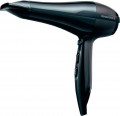Motor type
The type of electric motor installed in the hair dryer.
This parameter is specified if the device does not use a traditional collector (brush) direct current (DC) electric motor, but more advanced motor. The options here might be:
—
AC motor. Hair dryers equipped with alternating current (AC) motors use the same type of power found in regular electrical outlets. These AC motors offer several key advantages over their DC counterparts, including enhanced reliability, durability, and excellent resistance to high loads. They can operate at full power for extended periods without overheating, often lasting for at least 5 years even under continuous use. Additionally, AC motors provide more even heating and facilitate quick adjustments to temperature settings. As a result, hair dryers with AC motors are essential tools in professional settings such as hairdressers and beauty salons. However, the main drawback of AC motors is their relatively higher cost, making them less practical for occasional home use.
—
Brushless motor. A brushless electric motor, which eliminates the need for a traditional commutator and brush contacts, employs a built-in electronic circuit to control the current in the motor windings. Despite being more expensive than conventional brushed motors, they offer several advantages. These motors allow for more precise and wider range adjustments of engine speed an
...d airflow, resulting in higher efficiency and better overall performance for the same power consumption. Moreover, the absence of moving brush components enhances their durability, leading to significantly longer service lives compared to both AC and traditional brushed motors. However, due to their higher cost, brushless models are not widely used even in the professional industry.Power
The rated power of the device, in fact, is the power consumed by it when operating at maximum intensity.
The power of a hair dryer, particularly for hair dryers, is a crucial factor that determines the maximum intensity of the airflow and heating capabilities. When selecting a hair dryer based on this parameter, it's essential to consider the intended usage of the device. Models with a power below 1000 W may not be sufficient for proper hair drying, especially for long hair, and are more suitable for styling purposes. Some of these models, particularly inexpensive ones, can provide high heat with low airflow, requiring careful use. For versatile and effective use, both at home and in professional settings, it's recommended to choose a hair dryer with at least 1800 W, preferably
2000 W and higher. Higher power allows for intense airflow, effective hair drying even at lower temperatures, and provides a wide range of temperature and speed settings. Models with intermediate power levels, ranging from 1000 to 1800 W, are more suitable for travel and on-the-go use.
For curling irons, electric curlers, and similar devices, the heating intensity and speed depend directly on the power. The manufacturer carefully selects the heater's power to achieve specific performance characteristics, such as temperature and heating intensity. When choosing such devices, it's essential to focus on practical indicators and compare different mode
...ls based on power, especially if specific characteristics are not clearly stated, as seen in some inexpensive curling irons with basic functionality. In these cases, users should consider the weaker and more delicate their hair, the lower the temperature and less intense the heating should be. If unsure, it's safer to opt for a less powerful device, as it may take more time to curl hair, but it significantly reduces the risk of damaging the hair.Power/temperature control
—
Joint. In models with joint adjustment of power and “degree” of air flow, the parameters change at the touch of a button. Hair dryers usually have several fixed values of blowing intensity and air temperature.
—
Separate. Separate heat and temperature controls give you more freedom of choice when using your hair dryer and styler. The parameters of the flow force and temperature for hair dryers with separate adjustments change separately, which allows you to count on the optimal values of power and “degree” of blowing to avoid overdrying your hair.
Removable grille
The ability to remove the protective grille of the hair dryer without special tools and skills, by the user himself.
The grill serves as a protective cover for the air intake of the hair dryer, located on its back side. It plays a crucial role in safeguarding the fan and heating element from foreign objects and preventing direct contact with the blades or heated coil, ensuring user safety. Additionally, the grill can accommodate an extra air purification filter, benefiting both the user and the device's internal components.
The removable design of the grill greatly simplifies maintenance and repair tasks. Users can easily clean the grill and internal elements from dust and contaminants, replace or clean the filter, and fix minor issues. However, for more complex repair work, it is advisable to seek assistance from specialists.

